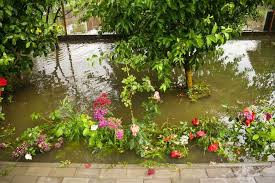How to Manage Garden Soil After Flooding
Floods can completely ruin your garden’s charm and result in tightly packed earth. All those treasured minerals get swept away, and a pile of random clutter finds its way into your space.
Keeping your outdoor area in good condition requires quick thinking and a proactive mindset. To prevent long-term harm, you’ll need to act fast and wisely.
The steps we’re about to reveal offer a practical route to bringing your patch back to life, no matter how badly it’s been affected.
Assessing Soil Condition
Start by getting your hands into the muck! Pick up some soil and give it a squeeze. If it feels gritty, you’re likely dealing with a sandy base. If it’s more silky and sticky, you’re looking at clay. This simple method helps you identify what lies beneath.
Next, dig a 15-centimetre pit, pour in some water, and see how quickly it soaks in. This tells you whether your ground absorbs moisture well or suffers from poor infiltration.
Take your fork and press it down into the bed. If it’s tough going, the ground can be compressed, making it hard for roots to expand or air to circulate properly. Take note of such spots.
Furthermore, walk around and observe which sections took the hardest hit — focus on displaced topsoil or lumpy build-ups. Once you’ve done a full loop, jot down the roughest areas so you’ll know exactly where to begin repairs.
Removing Debris and Contaminants
The clean-up starts here. Gather twigs, soggy leaves, and any random bits the flood may have swept in. Just be sure to wear gloves, as no one wants to come into contact with anything questionable or unhygienic.
Once you’ve cleared the larger items, look out for smaller bits of mess. Bag everything securely and follow disposal rules in your area. It’s also a good idea to double-check whether your council has flood-related waste guidelines.
Moreover, scrub your tools thoroughly to stop anything unwanted from spreading. Taking this step helps your garden bounce back sooner and limits any chance of cross-contamination during future use.
Aerating Compacted Soil
To treat tightly packed ground, grab your fork or a manual aerator. Poke tiny openings to let air and liquid pass through freely. This makes room for your plants and helps them take in more nutrients.
Focus on areas that feel solid underfoot or appear waterlogged. Make holes about 10 centimetres apart, giving roots room to branch out and establish themselves more easily. For best results, do this when the ground is slightly moist; it’s easier that way.
Remember not to go overboard. The goal is to improve the structure, not break it down completely. Keep this up regularly, and you’ll soon have thriving beds and visibly healthier growth.
Monitoring Soil Recovery Over Time
It’s not just about the first few days. Accordingly, monitor how your soil responds over the coming weeks. Notice whether pooling returns, new weeds appear, or growth looks uneven. These signs can indicate lingering issues.
You can use a garden journal or take occasional photos to document progress. This helps spot subtle improvements — or recurring trouble — that you can miss otherwise.
If growth remains sluggish or the ground hardens again, it could signal deeper imbalances. Consider retesting or adjusting your compost ratios as needed to address shifting conditions.
Being observant gives you a clearer idea of whether your current approach is working or needs to be tweaked slightly over time.
Testing pH and Nutrients
It’s vital to evaluate the state of your soil after flooding. You’ve got a few choices.
For example, try a home testing kit or opt for a lab report if you want more in-depth insight. In addition, you can gather samples from several locations in your garden for a well-rounded picture.
If you’re unsure, you can always ask gardening contractors for assistance. They can help interpret your results and recommend tailored amendments based on your garden’s specific needs.
When the findings come in, look for nutrient shortfalls caused by the flooding. This makes it much simpler to choose the right fix and bring your growing area back up to speed before planting.
Amending Soil with Organic Matter
After water has done its damage, rejuvenate your soil with some natural materials by spreading 5–7 centimetres of compost, rotted manure, or leaf litter across the top layer of your beds.
These elements not only replenish what was stripped away, but also improve water retention, structure, and nutrient density. Use a fork or spade to blend the material into the surface, enhancing both texture and richness in the process.
Beyond that, try to source materials locally if you can, as they’re typically more affordable and kinder to the environment. This ecologic habit gives your ground a fresh start and helps support new life.
Over time, this nourishing layer will break down and transform into a sponge-like foundation for vibrant growth.
Improving Drainage
If you don’t want water headaches down the line, make sure it drains the way it should.
A mix of coarse sand or gravel can really help loosen things up, especially in thick, stubborn clay.
Pay close attention to spots where puddles hang around or plants just never seem happy — those patches are practically calling out for help.
A simple setup like a French drain or even a shallow trench can be all you need to steer water clear of roots and stop things from going sour.
Furthermore, if your garden’s always a bit swampy? Toss in some moisture-loving grasses or cover crops that soak it all up without a fuss. These hardy ground covers don’t just stabilise the soil; they also help regulate moisture levels.
These small tweaks won’t just fix today’s problems; they’ll help your garden stand strong through whatever comes next. Heavy rain, biting wind, or a surprise snowfall — your space will be better prepared to handle it.
Replanting and Crop Rotation
After heavy rainfall, give the landscape a break. Allow it to dry fully before adding anything new. This pause lets the soil recover properly and return to its natural balance.
Then, start with resilient choices such as rye grass or clover. These tough plants support soil health and prepare the space for more sensitive types later on.
Changing what you grow is excellent for maintaining balance and avoiding pest issues. You’ll also reduce the risk of nutrient exhaustion in the same areas.
So, if you recently harvested greens, go for root crops or beans next time. Each variety offers different benefits and helps confuse persistent bugs.
Swapping crops every season also limits disease and keeps your garden producing well. Though it’s a traditional method, it’s still a brilliant trick for year-round success in modern gardens too.
Conclusion
Getting your garden back on its feet after a flood really does matter.
A bit of compost here, a touch of air there, and you’ll be well on your way to breathing life back into the soil and giving those roots the boost they need.
Just start sooner rather than later, and you’ll see your green space bounce back in no time. So don’t hang about — roll up your sleeves, get stuck in, and before you know it, your garden will be bursting with life again.




















